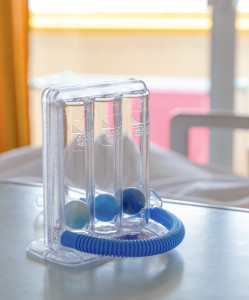COPD Rehabilitation: Dealing with a Serious Lung Disorder
COPD rehabilitation is a very helpful addition to drug therapy for people with moderate, severe, or very severe COPD signs and symptoms.
Chronic obstructive pulmonary disease (COPD) rehabilitation is a series of education and structured exercises that allow people to make the most of the remaining capacity of their lungs. People with COPD who engage in a rehabilitation program have less shortness of breath, an increased ability to exercise, better quality of life, and less frequent hospitalizations for COPD exacerbations than similar COPD patients who do not participate. It’s also possible that COPD rehabilitation will improve COPD life expectancy.
People with COPD signs and symptoms tend to decrease their physical activity as shortness of breath makes exertion more and more difficult. If your COPD prognosis is poor, you also may think you need to cut down on physical activity. However, decreased activity can start a vicious cycle of progressive deconditioning. This leads to a worsening of COPD symptoms and more breathlessness. COPD rehabilitation is aimed at breaking that cycle.
COPD Rehabilitation: Program Basics
COPD rehabilitation is more than an exercise program, although exercise is the most important component. According to the American Association of Cardiovascular and Pulmonary Rehabilitation (AACPR), pulmonary rehabilitation is tailored to the needs of individual patients, and is designed to optimize physical and social performance and autonomy.

A portable spirometer, called an “incentive” spirometer, challenges and recruits reluctant alveolae.
The AACPR lists the following core components for a COPD rehabilitation program:
- Exercise training and other therapeutic exercise (aerobic, strength, and flexibility training)
- Education and skills training (such as breathing retraining)
- Secretion clearance techniques
- Prevention and management of COPD exacerbations
- Control of irritants and allergens
- Instruction in proper use and safety of oxygen systems
- Nutritional assessment and intervention if necessary (Find out how a COPD diet might help you in our article on COPD home remedies.)
- Psychosocial assessment, support, panic control, and professional intervention, if necessary
- Help with smoking cessation if currently smoking
- Education about medication use
- Implementation of a home treatment program follow-up
COPD patients at all stages can benefit from a COPD rehabilitation program—in fact, one study found that patients in the earlier stages of COPD derived greater benefits than those in the later stages.
Although those with less advanced COPD had better results, those with severe COPD signs and symptoms also had improved ability to exercise, and less shortness of breath. This research suggests that when it comes to COPD rehabilitation, the earlier the better. However, all of the patients were helped by the program. Other studies have found that rehabilitation benefits are generally sustained for up to 18 months after the program ends, especially if the exercise training is maintained.
There are many COPD rehabilitation programs around the country. Your doctor can most likely refer you to one—alternately, the American Association for Cardiovascular and Pulmonary Rehabilitation (www.aacvpr.org) has a searchable online directory of rehabilitation programs. Health insurance may or may not cover COPD rehabilitation—you’ll need to check with your insurance carrier.
Medicare coverage of COPD rehabilitation can vary from state to state, so check with your doctor or provider to obtain the guidelines in your state.
See also these University Health News posts:
- “Lung Diseases and COPD Facts: Understanding the Breathing Process“
- “Lifestyle Changes Among the Keys to COPD Treatment“
- “Is There Such a Thing as a COPD Diet?“
Originally published in May 2016 and updated.


 What is a Pulse Oximeter?
What is a Pulse Oximeter?  Lung Detox or Lung Cleanse: Can You Clean Out Your Lungs Naturally?
Lung Detox or Lung Cleanse: Can You Clean Out Your Lungs Naturally?  Are There House Plants That Clean the Air?
Are There House Plants That Clean the Air? 
COPD rehabilitation involves steadily improving lung function. Here a COPD patient uses an "incentive spirometer" as a training device to build lung function. Diagnostic spirometers also require the patient to blow into a tube, but the device is designed to assess lung capacity prior to diagnosis.